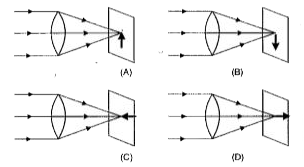The parallel rays form the top of a distant tree are incident on a concave mirror forming its image on a screen.
The diagram which shows the image of the tree on the screen correctly is :

A
B
C
D
The correct Answer is:B
NA
Topper's Solved these Questions
- BOOK - LAKHMIR SINGH & MANJIT KAURCHAPTER - THE HUMAN EYE AND THE COLOURFUL WORLD EXERCISE - Long Answer Type Question3videos
THE HUMAN EYE AND THE COLOURFUL WORLD
- BOOK - LAKHMIR SINGH & MANJIT KAURCHAPTER - THE HUMAN EYE AND THE COLOURFUL WORLD EXERCISE - NCERT Book14videos
THE HUMAN EYE AND THE COLOURFUL WORLD
- BOOK - LAKHMIR SINGH & MANJIT KAURCHAPTER - THE HUMAN EYE AND THE COLOURFUL WORLD EXERCISE - Long Answer Type Questions2videos
THE HUMAN EYE AND THE COLOURFUL WORLD
- BOOK - LAKHMIR SINGH & MANJIT KAURCHAPTER - TEST PAPER 4EXERCISE - SECTION A10videos
TEST PAPER 4
Similar Questions
Knowledge Check
- Question 1 - Select One
Parallel rays from a distant object incident on a convex lens form an image on the screen. The diagram showing correctly the image of the object on the screen is
 AABBCCDD
AABBCCDD - Question 2 - Select One
The image formed by a concave mirror
ArealBvirtualCmagnifiedDAll of the above - Question 3 - Select One
By using a concave mirror, image of a tree is focused on a screen. The distance between the screen and the mirror is _____
Aequal to radius of curvature of the mirror.Bequal to half the radius of curvature of the spherical mirror.Cequal to twice the focal length of the mirror.Dequal to one fourth the focal length of the mirror.
The image of a distant object is formed at 30 cm from a concave mirror. What is the focal length of the mirror?
View SolutionFour students A, B, C and D performed the experiment to determine the focal length of a concave mirror by obtaining the image of a distant tree on a screen. They measured the distances between the screen and the mirror as shown in the diagrams given below :

The correct value for focal length will be obtained by the student :View SolutionThe image formed by a concave mirror
View SolutionTo determine the approximate value of the focal length of a given concave mirror, you focus the image of a distant object formed by the mirror on a screen. The image obtained on the screen, as compared to the object is always:
View SolutionWhen the object is at focus of a concave mirror, the image is formed at
View Solution

